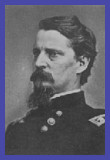Winfield Scott Hancock, along with his twin brother, Hilary were born on February 14, 1824 at Montgomery Square, Pennsylvania to Benjamin and Elisabeth Hancock. When Winfield was six years old, his father moved the family to Norristown, Pennsylvania where he began a law practice. At age sixteen, Winfield entered the Military Academy at West Point on July 1, 1840 and on July 1, 1844 he graduated 25 in his class.
When the War with Mexico began, Hancock was assigned to the quartermaster department but did not go to Mexico until 1847.
Upon the end of the war in 1848, Hancock and his regiment, the 6th United States Infantry, remained for sometime in Mexico City where he met a young Virginian by the name of Henry Heth. Hancock and Heth became close friends and when the 6th U.S. Infantry was transferred to Jefferson Barracks, in St. Louis Missouri, Heth was instrumental in introducing Hancock to Almira Russell, who Winfield married on January 24, 1850.
At the outbreak of the Civil War in 1861, Hancock was stationed in Los Angeles, California. Obtaining permission to leave his quartermaster duties, Hancock headed East to offer his services in the defense of the Union. Arriving in the City of Washington in September, Hancock was summoned to the Headquarters of Major General George B. McClellan. McClellan appointed Hancock, Brigadier General Of Volunteers on September 23, 1861. Hancock’s first action was during McClellan’s Peninsula Campaign, where he commanded a brigade at the Battle of Williamsburg on May 5, 1862. McClellan, in a letter to his wife after the battle, stated that "Hancock was superb yesterday." From that letter the sobriquet of "Hancock the Superb" was born.
Hancock’s military career was on the rise and he would be called upon to command some of the most difficult tasks that the Army of the Potomac would offer. At the Battle of Antietam, September 17, 1862, Hancock would assume command of the 1st Division of the II Corps at the Sunken Road (Bloody Lane). Promoted to Major General on November 29, 1862, Hancock led his division during the Battle of Fredericksburg and attacked the Confederate position along the Stone Wall at the foot of Marye’s Heights. May 3, 1863, Hancock and his Division served as the army’s rearguard as it crossed back over the Rappahannock River at the Battle of Chancellorsville. After the resignation of Darius N. Couch, May 22, 1863, Hancock assumes command of the II Corps and had little time to acquaint himself with his new command when orders came for the Army of the Potomac to proceed North, in pursuit of the Confederate Army of Northern Virginia. By July 1, 1863, Hancock and his II Corps were in Maryland when Major General George Gordon Meade, now commanding the Army of the Potomac, came to Hancock requesting him to go to Gettysburg, Pennsylvania and "take command of the Corps there."
At 3:30 PM, on July 1, 1863, Hancock arrived at East Cemetery Hill, just outside of Gettysburg, Pennsylvania and found the commander of the Union XI Corps, Major General Oliver Otis Howard, attempting to establish a defensive position. Hancock offered to show Howard the orders from Meade giving him command of the field but Howard did not wish to see them and told Hancock to "go ahead." Hancock then went to work establishing the Union battle line that would be known as the "Fish Hook.". For the next two days, Winfield Scott Hancock would play a significant role in the fighting at Gettysburg. On the second day of battle, Hancock sent the 1st Division of his II Corps to repair the damage to the Union left, caused when Major General Dan Sickles attempted to moved his III Corps forward into the Peach Orchard. Sickle’s action exposed the left flank of the army just as Confederate General Longstreet launched his attack towards the Round Tops. On the third day, General Meade had placed Hancock in command of the I and III Corps along with his own II Corps. Hancock was now commanding three fifths of the Army of the Potomac at Gettysburg when "Pickett’s Charge" took place on July 3, 1863. During the Confederate artillery bombardment, that preceded "Pickett’s Charge," Hancock rode along his line encouraging his men to hold their ground. A soldier who witnessed Hancock that day stated "his daring heroism and splendid presence gave the men new courage." Upon conclusion of the bombardment, the Confederate infantry assault began. Hancock was not idle during the attack and seemed to be everywhere on the battlefield directing regiments and brigades into the fight. As Hancock was approaching the Vermont Brigade commanded by Brigadier General George J. Stannard, he suddenly reeled in his saddle and began to fall to the ground. Two of Stannard’s officers sprang forward and caught Hancock as he fell, a bullet had torn through Hancock’s saddle and penetrated eight inches into his right groin. Refusing to be moved from the field, though in much pain, Hancock continued to direct and encourage his men. Upon the repulse of the Confederate attack, Hancock was removed from the field and taken to a field hospital. Eventually he would be taken to his father’s home in Norristown, Pennsylvania to recover. The Battle of Gettysburg was over and the Union victory would prove to be the result of the leadership of Major General Winfield Scott Hancock. On April 21, 1866, Hancock would receive the thanks of Congress for his "skill and heroic valor" during the Battle of Gettysburg.
Hancock returned to the Army of the Potomac in time for the 1864 campaign that would culminate in the ten month siege of Petersburg, Virginia. During that campaign, He would command his II Corps at the battles of the Wilderness, Spotsylvania Court House, North Anna River, Cold Harbor,Deep Bottom, Ream’s Station and the Boydton Plank Road. However, as a result of his Gettysburg wound, that continued to plague him, he would relinquish command of the II Corps on November 26, 1864. In April 1865, Hancock was summonsed to Washington to take charge of carrying out the orders of execution on the "Lincoln Conspirators." In 1867, Hancock would create controversy as commander of the 5th Military District of Louisiana and Texas when he issued General Order No. 40, returning civil law back to the people of those southern states.
By 1880, Hancock was the military commander of the Department of the Atlantic with his headquarters at Governor’s Island, located in New York Harbor. On June 24, 1880, Winfield Scott Hancock received the Democratic nomination for President of the United States but lost the election to James Garfield by only a small margin. During the election, Hancock was the first Northerner, since the war, to carry the Southern states in a Presidential election.
Upon the death of Ulysses S. Grant, Hancock was ordered by President Grover Cleveland, on August 8, 1885, to supervise and direct the funeral of the former President and General of the United States Army in New York City. This would be Winfield Scott Hancock’s last public appearance.
Major General Winfield Scott Hancock would end his life still on active duty at Governor’s Island, New York. He died on February 9, 1886 at 2:35 PM as a result of advanced diabetes, which was also the cause of his father’s death in 1867. After a brief funeral service at Trinity Church, in New York City, General Hancock’s remains were taken to his boyhood home of Norristown, Pennsylvania, where he was placed, alongside his daughter, Ada, in a mausoleum that he had designed in Montgomery Cemetery.
The history of Major General Winfield Scott Hancock is a story of an American hero who was dedicated to the Union and the United States. "Hancock the Superb, Thunderbolt of the Army of the Potomac," all are names that described his skill and valor during the Civil War but, perhaps the phrase used by former President Rutherford B. Hayes, upon Hancock’s death, sums up the life of the "Hero of Gettysburg," best when he said of him that " he was through and through pure gold."

SUGGESTED READINGS
Hancock at Gettysburg and Beyond
by A.M. Gambone
published by Butternut and Blue, 1997
Winfield Scott Hancock: A Soldier’s Life
by David M. Jordan
published by Indiana University Press, 1988
Hancock The Superb
by Glenn Tucker
published by Bobbs-Merrill Company Inc. 1960
reprinted from Morningside Books, 1980
General Hancock
by General Francis A. Walker
published by D. Appleton And Company, 1894
reprinted by Olde Soldier Books, 1987

§ THE W.S. HANCOCK SOCIETY
1939 WEST MARSHALL ST.
NORRISTOWN, PA 19403

